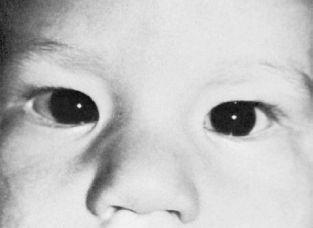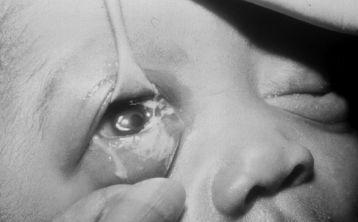Pediatric Examination and Board Review (250 page)
Read Pediatric Examination and Board Review Online
Authors: Robert Daum,Jason Canel

(A) ptosis
(B) limited eye movement
(C) conjunctival injection
(D) presence of discharge
(E) A and B
14.
You diagnose a 6-month-old child with nasolacrimal duct obstruction. Which sign is consistent with that diagnosis?
(A) tearing
(B) conjunctival injection
(C) maceration of the eyelid skin
(D) A and B
(E) A and C
15.
An infant has tearing, photophobia, corneal clouding, and corneal enlargement of one eye. The most likely diagnosis is
(A) cataract
(B) blocked tear duct
(C) mucopolysaccharidosis
(D) glaucoma
(E) retinal detachment
16.
A child has mild unilateral ptosis and miosis (small pupil) with ipsilateral anhidrosis of the face. An important diagnostic consideration is
(A) neuroblastoma
(B) retinoblastoma
(C) rhabdomyosarcoma
(D) Wilms tumor
(E) hemangioma
17.
A 6-year-old girl with pauciarticular juvenile idiopathic arthritis should have ophthalmologic screening for
(A) conjunctivitis
(B) scleritis
(C) optic neuritis
(D) uveitis
(E) keratitis
18.
An infant is being followed for retinopathy of prematurity. The presence of which finding will be most important in deciding to proceed with prompt laser therapy?
(A) retinal detachment
(B) cataract
(C) plus disease
(D) glaucoma
(E) either B or D
19.
Referral to what specialist would be most appropriate for an infant with marked bilateral optic nerve hypoplasia?
(A) rheumatologist
(B) dermatologist
(C) otolaryngologist
(D) endocrinologist
(E) pulmonologist
20.
An infant has a small and superficial strawberry hemangioma of the upper eyelid. If the lesion grows in size, which complication is most likely?
(A) cataract
(B) glaucoma
(C) amblyopia
(D) retinal detachment
(E) hyphema (bleeding into the anterior chamber of the eye)
21.
An infant has bilateral leukocoria. This finding may be caused by
(A) papilledema
(B) retinoblastoma
(C) cataract
(D) A and C
(E) B and C
22.
The most common ophthalmologic finding in neurofibromatosis type 1 is
(A) cataract
(B) retinal detachment
(C) anisocoria
(D) Lisch nodules
(E) optic nerve hypoplasia
23.
A child with Sturge-Weber syndrome should undergo screening for
(A) cataract
(B) ptosis
(C) glaucoma
(D) uveitis
(E) dry eye syndrome
24.
A 5-year-old child is poked in the eye with a pencil. The finding most likely to signify serious ocular damage is
(A) an irregular (nonround) pupil
(B) large subconjunctival hemorrhage
(C) corneal abrasion
(D) conjunctival injection
(E) excessive tearing
ANSWERS
1.
(B)
This describes the Bruckner test. Asymmetry of the red reflexes is produced by strabismus, anisometropia (different refractive errors of the two eyes), or media abnormality/opacity (cornea, lens, vitreous, retina) in 1 eye or asymmetrically in the 2 eyes. An eye with a small optic nerve would not manifest an abnormal red reflex in the absence of strabismus or another problem.
2.
(A)
Small-angle strabismus is most sensitively detected by cover testing, watching closely for any refixational movement of the uncovered eye. Corneal light reflex testing and evaluation of photos are relatively insensitive in detecting small-angle strabismus. Testing eye movements in various eccentric positions of gaze offers no information about the presence or absence of strabismus in the straight-ahead position. Refraction gives no direct assessment of ocular alignment (see
Figure 142-1
).

FIGURE 142-1
Epicanthus tarsalis. (Reproduced, with permission, from Riordan-Eva P, Whitcher JP. Vaughn & Asbury’s General Ophthalmology, 17th ed. McGraw-Hill; 2008: Fig. 4-5.)
3.
(C)
Farsightedness is a common cause of esotropia. If farsightedness is uncorrected, a child may see clearly but must accommodate excessively to do so. As part of the near reflex triad, accommodation is accompanied by pupillary miosis and convergence of the eyes, which could lead to esotropia.
4.
(D)
The child already has equal visual acuity in the 2 eyes (no amblyopia). The timing of surgery would have no impact on eyeglass need or surgical complications. The development of binocular fusion postoperatively requires plasticity of the visual system in the brain, and such plasticity diminishes with increasing age.
5.
(E)
“Crossing” of the eyes can be “normal” in two situations. First, visually immature babies in the first 2 months of life or so commonly manifest occasional esotropia or exotropia; this seems to be a normal phenomenon that disappears quickly after good fixation and following-behavior develops. Second, “crossing” due to pseudostrabismus, which is not true esotropia, occurs normally in children with a wide nasal bridge and/or epicanthal folds. In all other scenarios of true esotropia, prompt referral to an ophthalmologist is appropriate.
6.
(B)
The case describes anisometropic amblyopia of an eye, which is initially treated with eyeglasses. If the amblyopia is insufficiently responsive, supplemental therapy would include occlusion (patch) or penalization (atropine) of the sound eye. Traditionally, amblyopia has been treated up until 7-9 years of age, but recent research indicates that treatment benefits may be achieved even in older children.
7.
(D)
The fourth cranial nerve innervates the superior oblique muscle, which is primarily a depressor of the eye. Tilting the head compensates for this vertical strabismus, allowing the child to fuse, have depth perception, and avoid diplopia. Horizontal strabismus would not lead to a head tilt. Ptosis could lead to a chin-up head positioning but not to a head tilt.
8.
(A)
Convergence insufficiency is a common cause of eyestrain headaches in children, typically becoming symptomatic after 10-20 minutes of reading. A visual aura preceding a headache suggests migraine, a central process.
9.
(D)
Chin-up head posturing in a child with unilateral ptosis is taken as a positive sign, indicating the child is using the ptotic eye by gazing below the droopy eyelid. Absence of such posturing may indicate that the vision of the ptotic eye is being occluded and suppressed by the droopy eyelid (see
Figure 142-2
).

FIGURE 142-2
Congenital ptosis of severe degree, left upper lid.
10.
(D)
Eye blinking is a very common tic. Allergy would be accompanied by redness and itching. Dry eye is unusual in young children in the absence of systemic disease or medications associated with eye dryness; redness and/or the sensation of the presence of a foreign body would also be expected.
11.
(A)
Ophthalmia neonatorum with copious purulence is highly suggestive of gonococcal infection, which is treated by systemic antibiotics. Topical antibiotics are often additionally given but are not adequate for sole therapy (see
Figure 142-3
).

FIGURE 142-3
Neonatal conjunctivitis (ophthalmia neonatorum). Copious purulent drainage in a newborn with neonatal gonococcal conjunctivitis. (Reproduced, with permission, from Knoop KJ, Stack LB, Storrow AS, et al. Atlas of Emergency Medicine, 3rd ed. New York: McGraw-Hill; 2010:26. Photo contributor: Department of Ophthalmology, Naval Medical Center, Portsmouth, Virginia.)
12.
(D)
A corneal dendrite is highly specific for herpes infection, either simplex or zoster (see
Figure 142-4
).

